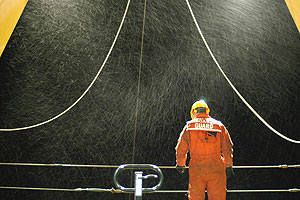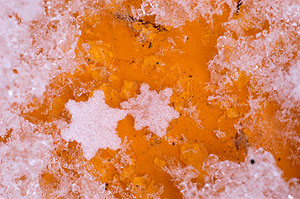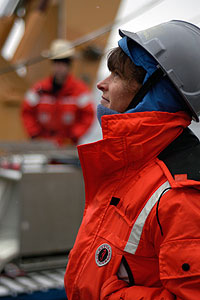|
|
 |
 |
Science
Crew Facts

It's Tom Weingartner's birthday today--Happy Birthday El Guapo! |
Daily Update
Calendar
Dispatch 26 - September 26, 2004
By C. A. Linder
Weather conditions: Partly cloudy skies, 20 kt winds, 5-7 ft
seas, air temperature 35°F
The Race is On
"Look at this, isn't it beautiful?" Bob Pickart was grinning and holding
a piece of paper. On it was a vaguely
round red blob, right in the middle of the page. "There's our eddy."
I was looking at a plot of the thickness of the eddy we have been
chasing for the past several days. Our XCTD survey captured it beautifully.
Through snow squalls and biting winds,
the CTD watchstanders and Marine Science
Technicians worked all night to sample
one final section right through the middle of this swirling mass of
shelf water. We hope to capture all the information that we can about
this oceanographic feature before we have to head south. As Bob was
showing me the plot, we were finishing the last VPR and multi-net
cast of the section.
During much of the past few weeks, intermittent snow
showers have dusted the ship. Very little snow has accumulated--just
enough for a short snowball fight. I asked Jessie Cherry,
a graduate student writing her doctoral dissertation on Arctic snow,
to describe what is known on the topic.
 |
|
 |
| Marine Science Technician Chad Klinesteker weathers a storm waiting for the CTD. |
No two are alike... Snowflakes on a mooring box. |
| Click to enlarge | |
Click to enlarge
|
Jessie: "We have a very poor estimate of how much snow falls in the Arctic. Even on land, where there are gauges, snow is very difficult to measure. A snow gauge is kind of like a bucket on top of a 2-meter tall pole. Some gauges are heated and the snow inside is melted and measured automatically. Others are emptied by a person every day or week. The problem is that much of the snow blows horizontally, just like we have been seeing here at sea. So the snow never falls into the gauge. Another problem is the presence of the gauge actually causes some turbulence in the atmosphere around it. This turbulence from the gauge acts as a little gust of wind that blows snow away from the bucket part of the gauge. Some gauges are believed to underestimate the snowfall by as much as 100%."
 |
 |
| Maureen Taylor waits for a signal from the aft conn to begin the last VPR cast. |
Click to enlarge
|
How much snow falls over the Arctic Ocean?
Jessie: "Scientists have absolutely no idea how much snow falls over the open ocean up here. As you can tell from our Daily Dispatches, the air temperature is right around the freezing point. Only when we were on the ice did it get colder. So even when it snows here, some of the snow will sublimate (turn into water vapor) before it hits the water. In the central Arctic Ocean there were some historic gauges on the ice, deployed by Russian scientists, but by the time air masses reach the central Arctic, there is very little moisture left, so snow amounts are very small and for that reason are even more difficult to measure."
Where does the snow go when it melts?
Jessie: "Snow that falls on land as far south as 45°N melts and flows into rivers that discharge into the Arctic Ocean. Some of the snowmelt evaporates, but the presence of permafrost (permanently frozen soil) means that the soil can’t absorb very much water, so it flows into streams and rivers. This becomes a major source of freshwater for the entire Arctic Ocean. We can see this freshwater in many of our CTD measurements."
Now that our eddy chasing is complete, we are speeding south as fast
as we can. We have a new sense of urgency to retrieve our last mooring
in the Chukchi Sea central channel. The latest forecast calls for
the winds to increase to gale force (35 knots and higher) by tomorrow
morning. If the seas become rough, it may become too dangerous to
launch the small boat to hook the mooring. Since we need to start
heading for Nome by Wednesday afternoon, time is definitely running
out. Stay tuned for tomorrow's dispatch to see if Mother Nature interferes
with our mooring retrieval plans...

|
Traducido al Español por
Mifaya
|
La carrera esta en marcha
“Mira esto, no es precioso?” Bob Pickart estaba emocionado sosteniendo
un trozo de papel. En el había una globo
redondeado de color rojo, justo en el centro de la hoja. “Ahí esta
nuestro eddy” dijo mientras mirábamos un plano en donde estaba el
eddy que habíamos estado buscando los dias anteriores. Nuestro XCTD
lo capturo. A través de copos de nieve y vientos mordientes, los técnicos
marinos y los encargados de la CTD trabajaron
toda la noche para muestrear una sección
final justo en el medio de la masa de agua de la plataforma. Esperamos
encontrar toda la información que podamos sobre este fenómeno oceanográfico
antes de dirigirnos al sur. Mientras Bob me enseñaba el mapa, estábamos
terminando la ultima VPR y la ultima multi-net
de la sección.
Durante las semanas pasadas, intermitentes
nevadas han ensuciado el barco. Se acumulado muy poca nieve en
el barco pero la suficiente para hacer una corta pelea de nieve. Le
pregunte a Jessie Cherry, una estudiante graduada que esta haciendo
su doctorado sobre nieve del Ártico, para saber que se sabe sobre
la nieve.
Jessie: “Sabemos muy poco sobre cuanta nieve cae
en el Ártico. Incluso en tierra, donde hay palos de 2 metros para
medir la nieve, es muy difícil de medir. Algunos de estos palos se
calientan y se mide directamente la nieve que se derrite en su interior.
Otros se vacían por una persona cada dia o semana. El problema es
que loa mayoría de la nieve cae horizontalmente, como hemos visto
aquí en el mar. Asi que la nieve nunca cae dentro del palo. Otro problema
es que la presencia del palo produce una turbulencia en la atmósfera
alrededor del palo que actúa como remolino de viento que se lleva
la nieve del agujero del palo. Algunos de estos palos se creen que
desestiman la nieve caida hasta un 100%.”
Cuanta nieve cae sobre el Océano Ártico?
Jessie: “Los científicos no tienen ni idea de cuanta
nieve cae en mar abierto aquí. Como puedes ver en nuestros comunicados
diarios, la temperatura del aire esta alrededor del punto de congelación.
Solo cuando estuvimos cerca del hielo, la temperatura bajo mas. Así
que cuando cuando aquí nieva, parte de la nieve se transforma en vapor
de agua antes de llegar al agua. En el centro del Océano Ártico había
algunos palos en el hielo, dejados por los científicos rusos. Cuando
las masas de aire alcanzan el centro del Ártico, queda muy poca humedad
y por tanto, los acumulos de nieve son muy pequeños y por tanto, mas
difícil de medir.”
A donde va la nieve cuando se derrite?
Jessie: “La nieve que cae a 45º N se derrite y fluye
por los ríos que descargan al Océano Ártico. Parte de esa nieve derretida
se evaporo, pero la presencia de permafrost indica que el sustrato
no puede absorber mucho agua, así que fluye hacia ríos y arroyos.
Esto constituye una gran cantidad de agua dulce para el Océano Ártico.
Podemos ver esta agua dulce en muchas de nuestras muestras de CTD.”
Ahora que nuestro muestreo del eddy esta complete, nos dirigimos rápido al sur. Tenemos una nueva urgencia de retirar nuestro ultimo mooring en el canal central del mar de Chukchi. Las ultimas noticias meteorológicas dicen que el viento va a soplar de 35 nudos o mas para mañana por la mañana. Si el mar empeora puede resultar muy peligroso para lanzar la zodiak para recoger el mooring. Ya que tenemos que dirigirnos a Nome el miércoles por la tarde, el tiempo se esta acabando. Permanece atento al comunicado de mañana para ver si la madre naturaleza interfiere con nuestros planes de recogida del mooring…
 Previous
Dispatch
Next Dispatch Previous
Dispatch
Next Dispatch

Back to Calendar
|
|




